ARTIFICIAL LIFT
What’s new in artificial lift?
Part 2-Ten companies offer 16 surface and downhole innovations for electric submersible pumping and other artificial lift operations.
James F. Lea, PLTech LLC; Herald W. Winkler, Texas Tech University; Robert E. Snyder, Consultant; and Peter O. Oyewole, BP America Inc.
Part 1, presented last month, described 19 recent downhole and surface equipment developments in three categories: sucker rod pumping; Progressing Cavity Pumping (PCP); and gas lift.
This concluding article discusses recent equipment technology introduced and applied for installing and more efficiently operating and maintaining Electric Submersible Pump (ESP) systems. Also covered are miscellaneous new developments including: new hydraulic pumps; improved thermal recovery with steam; updated chemical injection; and fluid level and pump-off control technology.
ELECTRIC SUBMERSIBLE PUMPS
Described here are eight new systems: a low-flow, low-horsepower ESP; a low-cost cable clamp; an automatic bypass sub; a flapper-type fluid loss valve; new power cables; a variable-speed drive; downhole ESP monitoring; and an ESP assembly cap.
Low-flow, low-power ESP. Baker Hughes Centrilift has developed a low-flow, low-horsepower ESP system designed for wells up to 6,000 ft deep with flowrates up to 400 bpd and horsepower requirements up to 40 hp. The system provides operators a cost-effective solution with a greater operating range and reliability vs. other forms of artificial lift, particularly in deviated wells. In such low-flow applications, the system can replace rod lift to provide maximum fluid drawdown, pump-off control, enhanced performance in abrasive environments and production flexibility.
The integral motor seal combination uses a single shaft. The motor comes in 20- and 40-hp models for low flows. The standard OD is 4.4 in. to allow for a recirculation system or shroud if needed for wells with high gas content in the fluid or with systems set below the perforations. The motor, rated for 170°F bottomhole temperature, has a glacier thrust bearing and Viton seal for thrust up to 6,000 ft.
Three main pump designs are offered for low-flow, low-horsepower applications. The 26- and 129-stage upper, and 186-stage middle, tandems can be combined or used independently. The P3 pump stage includes the Centrilift Centurion pump design hydraulics with wider vane openings, Fig. 1. The wider vane openings serve to minimize solids impact, increase head per stage and add particle swirl suppression for abrasion resistance. The motor/seal has a base capable of housing a new Centrilift downhole sensor.
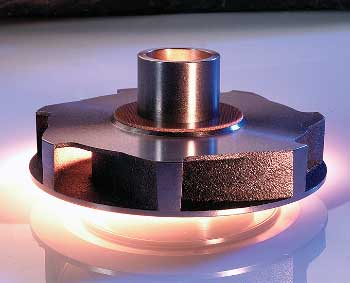 |
Fig. 1. Wider vane openings in Baker Hughes Centrilift’s new low-flow, low-horsepower ESP minimize solids impact and provide increased head per stage.
|
|
ESP cable damage relief. Artificial Lift Company, based in the UK, has developed a low-cost cable-protection clamp, Fig. 2. Frequently, adequate wellbore clearance for ESP deployment may not be available. Industry has used a flat cable configuration, instead of round, to alleviate clearance and cable damage. However, flat cable alone with regular bands does not provide sufficient clearance to prevent damage in some tight-clearance applications, especially at tubing joint bulges.
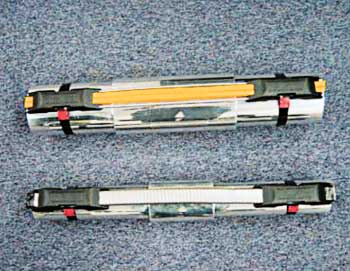 |
Fig. 2. Artificial Lift Company’s new cable clamp for ESP deployment has undergone extensive testing for rugged oil and gas applications.
|
|
The new cable protector, called BossCLAMP, is designed to mitigate cable damage at minimal cost. Made of a composite material, it accommodates any combination of tubing diameter, cable type, configuration and combinations, from conventional flat ESP cables to control lines and intelligent-well instrumentation cable. This flexibility minimizes inventory and allows use of the same cable protector on various applications, which increases the feasibility of cable reuse.
Other features of the new system include low sidewall friction, low profile, and neutrality in completion fluid; i.e., no galvanic corrosion. It is reusable and easy to install and remove. The clamp has undergone extensive load, abrasion and temperature testing.
Automatic ESP bypass. Caledyne Ltd., of Aberdeen and Houston, offers the Auto-Bypass Sub, a tubing-mounted downhole tool that is installed as part of an ESP completion in which the well can flow without assistance, Fig. 3a. The sub is located above the ESP and allows production to pass through annular ports when the pump is switched off. When the ESP is on, the sub closes the ports. Discharge pressure keeps the sub closed. When the pump is switched off, the sub reopens, allowing communication to the annulus.
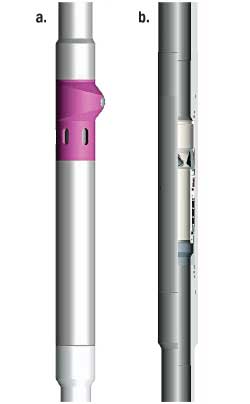 |
Fig. 3. Caledyne’s automatic ESP bypass (a), mounted on the tubing above an ESP, allows flowing production through annular ports when the pump is shut off. The fluid-loss valve (b) uses cone-shaped flappers to open and close automatically.
|
|
Rerouting flow around-rather than through-the ESP may improve production. Other key benefits include:
- Reduced scale, wear and debris buildup at the pump when it is not running, by channeling flow through annular ports
- Increased production from flowing wells by bypassing the ESP restriction
- No control lines or wireline intervention
- Accommodation of ESP cable bypass.
Applications in flowing wells with an ESP include tubing sizes of 2⅜ to 4½ in.
Fluid-loss valve. Caledyne’s Cone Flapper fluid-loss valve uses a cone-shaped flapper section divided into three sections, Fig. 3b. Normally closed, the valve flappers are self-sealing and open automatically when the well is flowing. Backflow acts against the flappers, with higher pressures enhancing the seal between the sections.
The tool may be suspended below a retrievable packer in ESP wells to protect the formation against damage and for maintaining fluid levels within the wellbore, to protect the pump at startup. The tool features a large through bore and is interventionless; i.e., no manipulation is required to operate the tool.
ESP power cables. Schlumberger has developed RedaMAX ESP power cables that take advantage of new material compounds and manufacturing processes, Fig. 4. The elastomer formulations improve dialectric and tensile strength, swell properties and elongation. Main ESP power cables are now rated between 180 and 450°F, and the motor lead extension is rated to 500°F for high-temperature applications. The manufacturing process has provided for dimensional improvements in materials, yielding a high-quality, long-lasting power cable for ESP wells.
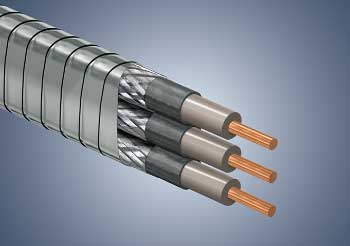 |
Fig. 4. New materials and processes in Schlumberger’s ESP power cables provide better performance and a longer life in the most hostile applications.
|
|
Variable-speed drive. To meet increasing demand for higher power and optimum control of pumping systems, Schlumberger has launched the SpeedStar Medium Voltage Drive (MVD) variable-speed drive, Fig. 5. These drives accept input of 3,300–6,900 V and put out up to 4,500 V, eliminating the need to step down incoming electricity to 480 V and then step up output to the required voltage. The drives are built in 24- and 36-pulse transformer capacity with pre-charged circuitry to minimize harmonics reflected back to the power supply.
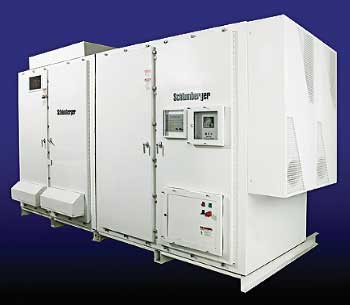 |
Fig. 5. The medium-voltage variable-speed drive, rated for 500 to 2,000 hp, protects and controls ESPs in harsh environments where the power supply is 3.3-6.9 kV.
|
|
The MVD comes with output sine-wave filters that eliminate downstream harmonics, thus reducing stress on the electrical system. These drives are available in both Nema 1 (indoor) and Nema 3 (outdoor) construction and range in size from 500 to 2,000 hp.
ESP monitoring system. Downhole monitoring for artificial lift systems provides critical information on performance of the lift systems and on inflow from the reservoir. Part 1 of this series introduced Schlumberger’s Phoenix Select digital Cable-To-Surface (CTS) downhole monitoring system for rod pumps, PCPs and gas lift systems. The CTS provides pressure and temperature of wellbore and tubing.
The company’s monitoring system for ESP applications, sold under the same brand, provides data from the traditional point, at the bottom of the ESP, and has added optional remote sensors at both the pump discharge and intake, providing information to diagnose ESP performance and enable pressure transient analysis, Fig. 6. Gauges are rated for 302°F downhole and provide pressure resolution to 0.1 psi for improved pressure transient analysis.
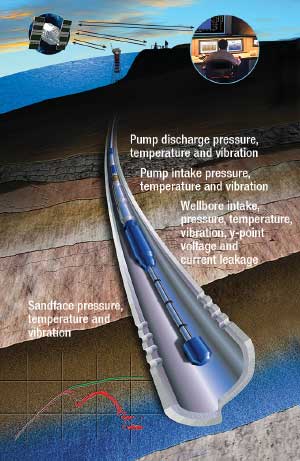 |
Fig. 6. Schlumberger’s latest downhole monitoring system for ESP applications provides high-quality data from more points than were previously available.
|
|
Plug-and-play ESP. Conventional ESP installations require that critical assembly operations, such as protector shimming and oil servicing of motors and protectors, be done at the wellsite, where these operations are dependent on the weather and other factors. However, this need is eliminated by Schlumberger’s REDA Maximus ESP system. The plug-and-play design consists of a protector, motor, gauge and motor-lead extension.
The assembly is constructed in the clean environment of a service or manufacturing center and arrives ready to install. The unique compensating shipping cap and positive sealing mechanism allow for thermal expansion and contraction of the oil during transportation. Most wellsite tasks, such as placing of couplings, changing protector plugs and oil servicing, are eliminated. The components are simply connected and run in the well. Use of these systems has reduced assembly time by about 40%.
BEYOND ESP
Besides ESP technology, eight other new developments in artificial lift are presented, including five tools for dewatering gas wells.
Hydraulic dewatering pump. Global Energy Services Ltd., of Calgary, has developed and applied the Activator Hydraulic Submersible Pump (HSP), designed to address problems associated with the dewatering of low-pressure coalbed methane and conventional gas wells at low rates (0.5-150 bpd).
The downhole pump is powered from surface using hydraulic pressure rather than sucker rods, making it less complicated to service. Also, eliminating the use of rods avoids mechanical erosion issues such as rod parting and tubing wear. A piston powered by the surface hydraulics brings in the fluid from the formation, Fig. 7.
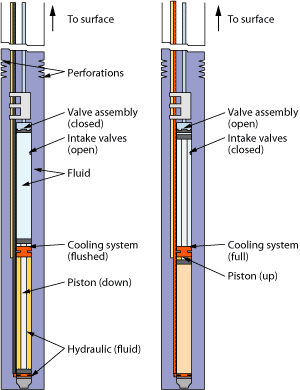 |
Fig. 7. Global Energy Services’ low-rate dewatering pump (0.5-150 bpd) is operated by a hydraulic fluid-driven piston that lifts incoming liquid to surface.
|
|
The HSP’s positive displacement is ideally suited for horizontal, slant and deviated wells. The pump runs off coiled tubing, so a service rig is not required.
The HSP is a key tool in CBM and low-pressure gas wells because it accommodates large amounts of gas and has a wide operating range at low rates. It functions effectively in harsh environments defined by high iron content in water, sludge, contaminants, sand and particulates. It is adaptable to fluctuating conditions downhole because its surface equipment has variable-speed dials to adjust.
Other key benefits of the pump are that it is less prone to gas locking than other artificial lift methods, it handles coal fines and sand, there is no rod or tubing wear associated with its use, and it can be installed in live wells. It has been deployed by several producers. Some have used it to test suspended or marginal liquid gas wells, many with 1- to 2-year runs. One operator deployed the HSP in its horizontal CBM well at 88° from vertical; it has run for over 2 years.
Insertable diaphragm pump. Another hydraulically operated pump for dewatering CBM wells-the Hydraulic Diaphragm Insertable (HDI) pump offered by Smith Lift, a division of Smith International Inc.-has had several successful deployments in the San Juan and Cherokee Basins. The pump has a 1¾-in. OD and is designed to fit inside 2⅜-in. tubing, Fig. 8. Hydraulic power is conveyed to the pump via the deployment string.
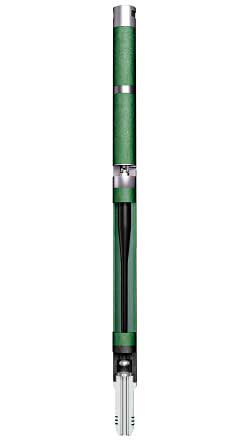 |
Fig. 8. Smith Lift’s insertable diaphragm pump uses hydraulic power conveyed via the deployment string.
|
|
The San Juan installations use concentric coiled tubing and have been run in vertical and deviated wells. Water production rates vary from 1 to 100 bpd, and wells produce between 50 and 1,500 Mcfd. In Cherokee, shallow CBM wells use two side-by-side plastic lines as the deployment string, and produce 20 to 80 bpd of water.
A conventional rod-pumped well may be converted by removing the rods and running the HDI to seat in a standard seating nipple. The internal pumping mechanism is isolated from the well fluid, providing a higher tolerance to solids since the standard plunger-to-barrel interface is replaced with a diaphragm. The pump can also run dry after pumping off the well. The surface unit has a low physical profile and runs on electricity or on gas, which can be produced on site.
Deliquefying chemical injection. ABB Totalflow, with its main office in Bartlesville, Oklahoma, offers two systems for controlling liquid removal problems in gas wells where foaming and other problems prevent efficient gas flow.
Soap stick launcher control. Using the flexible XSeries technology, automatic launch of soap stick by remote terminal unit is now available, Fig. 9. The device monitors flowrate, measured either by measurement tube or by critical velocity, and launches a soap stick when a low flowrate condition exists for a given period of time.
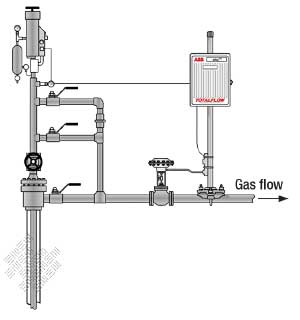 |
Fig. 9. ABB Totalflow’s automatic soap stick launcher, placed on the wellhead of a gas well, controls liquid buildup by remote terminal unit.
|
|
Successive soap sticks can be launched based on time delay and low-flowrate settings. They will continue to launch until a maximum number determined by the user is dropped, after which the system discontinues dropping and sets an alarm.
Chemical injection with plunger lift. XSeries technology is also used in a new program combining chemical injection control and plunger lift automation. Instead of having a chemical pump run continuously during all cycles of a lift system, the program takes advantage of information stored in the XSeries device to calculate the amount of chemicals needed to treat the tubing water slug.
It then uses the pump rate to determine appropriate pump run time to achieve desired chemical injection. The pump starts when the valve closes, runs for the determined time and then turns off until the end of the plunger-lift flow cycle.
Unloading selector. Weatherford introduces an unloading selector to help operators quickly pick a method for dewatering gas wells based on easily available, surface-gathered well data. This type of “quick pick” selection of artificial lift technique is especially valuable for operators who have purchased multiple wells with limited available well data.
The unloading selector works by assigning a high or low value to each of four surface-gathered data points:
- Liquid rate
- Flowing tubing pressure
- Watercut
- Gas-liquid ratio.
Starting in the middle of the selection tool, the operator then matches the answers to these four variables. The outermost ring of the selection tool shows the recommended artificial lift method, Fig. 10.
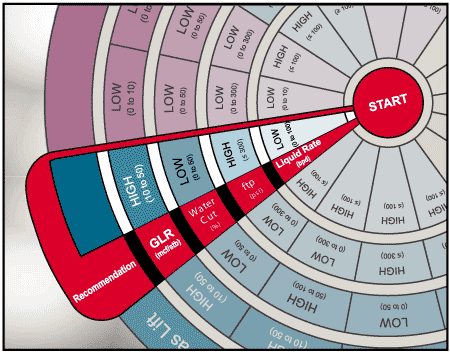 |
Fig. 10. Weatherford’s unloading selector tool helps operators quickly pick a method for dewatering gas wells based on easily available, surface-gathered well data.
|
|
Corresponding flow charts for each lift type confirm the selection or suggest an alternative lift method, based on more specific questions. The tool offers a useful starting point for more in-depth evaluation of dewatering method.
Efficient steam injection. Weatherford’s patented SteamSaver injection system for enhanced thermal recovery applications controls steam injection rate and maintains steam quality into multiple layered reservoir zones by locating individual injectors between packers, Fig. 11. This control reduces capital costs for downhole and surface equipment required per injector well completion.
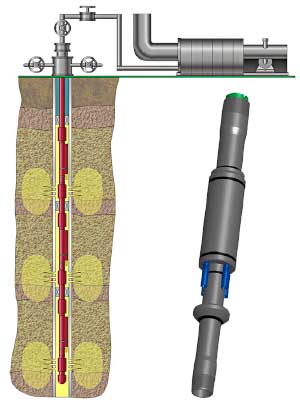 |
Fig. 11. Weatherford’s downhole selective steam injection system (left) locates individual injectors between packers. The steam passes from inside the tubing into the tubing casing annulus via small tubulars (right) for injection into the perforated formation sections.
|
|
Additional beneficial reductions are realized in the: 1) number of injectors required for improved formation liquid recovery; 2) number of tubing strings; and 3) reduced wellbore size.
Furthermore, the system minimizes surface injection pressure requirements. In SAGD applications in long horizontal wells, the system distributes heat from heel to toe of the wellbore.
Acoustic fluid level detection. Echometer Company of Wichita Falls, Texas, has released a new version of the well-known Echometer Model M fluid level instrument. This dual-channel, microprocessor-controlled amplifier/recorder permits interpretation of acoustic records by processing and simultaneously recording acoustic signals using two separate amplifiers that have independent gains and frequency response. This greatly improves the ability to detect collar echoes at greater depths and to distinguish downhole obstructions from enlargements, thus yielding a more precise analysis. The dual-channel instrument accents and records collar echoes on one channel and liquid-level response on the second channel.
The new microprocessor is programed to evaluate background noise in the wellbore and alert the operator to increase gas gun pressure above the recommended minimum when recording in a noisy well.
There are two modes of operation, depending on the type of acoustic gas gun used. When the new instrument is used with a manually fired gas gun, the user selects the special “Arm” mode, in which the recorder waits until the shot is fired and detected before printing. With a remotely fired gas gun, the user selects the standard mode, in which the instrument fires the shot and starts recording automatically. The entire instrument is contained in a waterproof plastic housing of 11 x 10 x 5 in. and weighs 11 lb.
Pump-off controller. D-Jax Corp. of Midland, Texas, has added dynamometer card and SCADA capability to its Penny Pincher pump-off controller. Dynamometer cards can be obtained via portable computer at the wellsite, or remotely using SCADA telemetry software. Peak and minimum loads, surface and downhole dynamometer cards, and the last five dynamometer cards prior to shutdown are available. Operators of the standard model can easily upgrade their pump-off controls.
The upgraded pump-off controller is now SCADA-ready, which means all data displayed on the LCD can be retrieved via telemetry to SCADA software offered by several vendors. Status, run times, 30-day run history and operational setpoints can be monitored and altered remotely if desired, using either radio, cell phone or satellite communication. 
|
THE AUTHORS
|
|
James F. Lea teaches industry courses in artificial lift and production for Petroskills. He holds BS and MS degrees in mechanical engineering from the University of Arkansas and a PhD in mechanical engineering from Southern Methodist University. He worked for Sun Oil Co. as a research engineer from 1970 to 1975, taught at the University of Arkansas from 1975 to 1978, was team leader of production optimization and artificial lift at Amoco EPTG from 1979 to 1999 and was chairman of Texas Tech University’s petroleum engineering department from 1999 to 2006.
|
|
|
Herald W. Winkler is former chairman of and now a professor emeritus and research associate in Texas Tech University’s petroleum engineering department in Lubbock, Texas. He works as a consultant in artificial lift, specializing in gas lift.
|
|
|
Robert E. Snyder, consultant, retired from Gulf Publishing Co. in 2006. He earned a BS degree in mechanical engineering from the University of Wyoming in 1957; served two years in the US Air Force; worked 10 years for Marathon Oil Co.; 29 years for GPC; and seven years for Completion Technology Co. Within GPC, he served as engineering editor and as editor of Ocean Industry and World Oil.
|
|
|
Peter O. Oyewole is an artificial lift production engineer for BP America Inc. in Durango, Colorado. He oversees artificial lift performance and optimization for tight gas and coalbed methane dewatering operations in North San Juan Asset. This also includes artificial lift selection strategy and technology development. Mr. Oyewole has over 10 years of oil and gas experience including positions with Schlumberger, Valero, Texaco and others. He earned a BS degree at the University of Ibadan, Nigeria, and an master’s degree at the University of Houston, both in petroleum engineering. Mr. Oyewole is an IADC (WellCAP) certified well control instructor. He teaches well control at San Juan College and has authored and co-authored several SPE and IPTC papers.
|
|
|

















